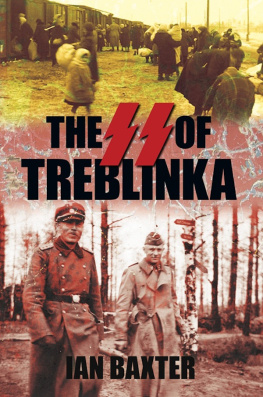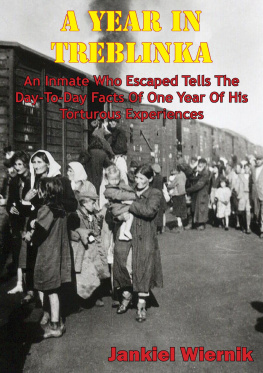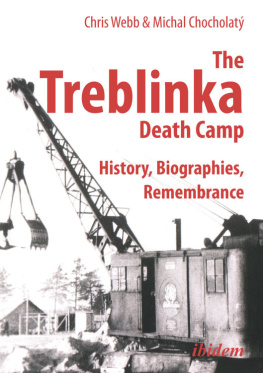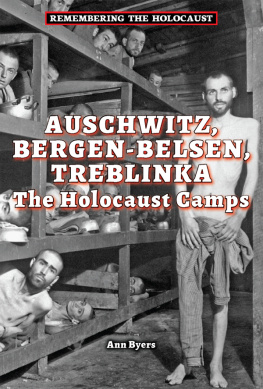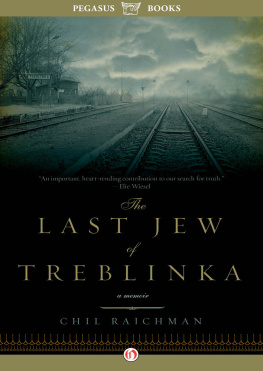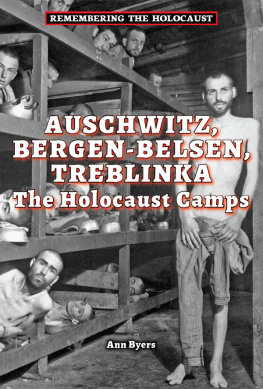Chil Rajchman
TREBLINKA
A Survivors Memory
19421943
Translated from the Yiddish by Solon Beinfeld
It is the writers duty to tell the terrible truth, and it is a readers civic duty to learn this truth. To turn away, to close ones eyes and walk past is to insult the memory of those who perished.
Vasily Grossman
The time had passed when each new day was bright, precious and unique: the future stood before us, grey and shapeless, like an impenetrable barrier.
For us, history had stopped.
Primo Levi

In mid-April 1945, American G.I.s liberated Buchenwald, while British soldiers marched, horrified, into Bergen-Belsen. There they found scenes of unimaginable suffering, men of bones and skin standing somehow on spindly legs amidst piles of emaciated corpses. Celebrated journalists documented what must have seemed the nether pole of human depravity, the worst an inhuman regime could achieve. Even as thousands of typhus-stricken survivors died, witnesses to a liberation that came too late for them, Margaret Bourke-White took chilling photographs that captured the consequences of the Nazi designs. A picture of evil was set, but Treblinka was absent from it.
Chil Rajchmans memoir of that place lay in Yiddish manuscript for decades, and the very name Treblinka became widely known only many years after the wars end. Yet Rajchman was witness to a very different reality, at a site the Nazis had wanted desperately to wipe from the map. It was further east, in the territories liberated by the Red Army, where far more pitiless dynamics of killing were unleashed than those that came to light at Belsen and Buchenwald. The Nazi project of extermination reached its most terrible extremity in Treblinka, and at other industrial killing centres whose names were similarly unknown.
These were places very different from the western concentration camps, which became lethal only in the last months of the war, as a failed regime lost its ability to feed its prisoners. In the eastern killing facilities, by contrast, the Nazi state did what it set out to do once it had chosen the final solution of gassing.
Unlike in the west, in the east the victims were dealt immediate execution on arrival, and died as Jews targeted by the regime.
Next to no-one survived: compared to the scores of memoirs testifying to the concentrations camps which, though terrible, were generally not intended to kill, only a paltry number could write of their experiences in the death camps. Just those few who, like Rajchman, were selected to operate the machinery of extermination in the Sonderkommando of the killing centre, and who were not put to death themselves along the way, could tell of what happened.
Rajchmans astonishing memoir drafted mostly in hiding before the Soviets reached Warsaw, where he had fled after his unlikely survival and escape is one of the most explicit descriptions of the Nazi project of extermination at its most spare and deadly. Indeed, the era can be known for its true horror thanks only to a handful of texts like this one.
* * *
In contrast to the western concentration camps, which were established before World War II for Adolf Hitlers various internal enemies (communists and criminals were their main residents until the war, and indeed during much of it), the extermination camps of the east appeared in the heat of conflict on the eastern front. In the second half of 1941 the process of exterminating the Jews gradually shifted. Dominated immediately after Germanys invasion of the Soviet Union by mass shootings beyond the MolotovRibbentrop line, it now turned into a policy of constructing death factories behind it, as incursions in the east in Operation Barbarossa slowed and a lightning victory came to seem out of reach.
Following Heinrich Himmlers orders, the S.S. began by setting up Che mno, in the Wartheland district of Greater Germany, and then Bezec and Sobibr across the border in the General Government, as the Nazis called their new colony made up of former Polish territories. Then Himmler ordered the erection of a new site, closer to Warsaw, also part of the General Government and its largest city. Situated some ninety kilometres northeast of the city on the Bug river, Treblinka was completed in June 1942. It became the centrepiece of Operation Reinhard, as the project of exterminating the Jews of the General Government came to be known (in honour of Reinhard Heydrich, a lieutenant of Himmlers who had been assassinated that spring). In the end, 1.3 million Jews were killed as part of the operation nearly 800,000 of them at Treblinka itself in not much more than a year.
As if his destiny of living through so much death cuts him off from his previous existence, Rajchman tells nothing of his life before the grim freight waggons bear him to this place in the memoirs opening lines. But more information is available in testimonies he later recorded for the United States Holocaust Memorial Museum in 1988, and for the U.S.C. Shoah Foundation Institute in 1994. Born Yekhiel Meyer Rajchman Chil for short on 14 June, 1914, in Ld, he fled east with a sister as the Germans invaded Poland in 1939. When the final solution began in earnest with the Soviet campaign two years later, Rajchman found himself in the vicinity of Lublin, from where he was deported to Treblinka in the round-ups intended to erase a millennial Jewish presence from the area.
Arrival at Treblinka meant the immediate loss of his sister, along with all the other women and children with whom he travelled there. The only work for which selection is possible at a death camp is for the handful of men needed to run the camp itself. Across the MolotovRibbentrop line, mobile killing units took on the job of extermination; at Treblinka, as at the other death facilities, the logistics of destruction called for only a few dozen S.S., some assistants (mostly Ukrainian) and the Jews themselves. Rajchman refers to his killers indiscriminately as murderers, with only a few singled out by name or nickname, notably Kurt Franz, the doll, notorious for his dog, his vanity and his cruelty. Rajchman knows the cremation specialist (almost certainly Herbert Floss) summoned for his expertise simply as the artist. And in passing he mentions Ivan, dubbed the terrible, a sadistic brute whom Rajchman later believed he recognized in Ivan Demjanjuk, and at whose American trial he testified.
* * *
Rajchmans memoir is above all else an incisive depiction of how the Nazis organized the destruction of millions of human beings and, indeed, reorganized it as time went on. As a worker he moves from Treblinka 1 to Treblinka 2, sections of the killing centre compartmentalized from each other by the gas chambers, to which arriving Jews are led along the Schlauch, the corridor the Germans euphemistically dubbed the road to heaven. Rajchman avoids that route somehow, and observes how man-made mass death is implemented. If he knows on arrival what this place is poignantly telling his sister not to bother taking their bags from the train he learns the details of its professional evil only through harsh experience.
In brief, succeeding chapters, Rajchman tells of the infernal division of labour, through which the steps in the process of extermination are carefully apportioned, and whose shifting roles allow him to survive. He begins as a barber, shearing womens hair prior to their gassing, a fate many of them clearly foresee in one of Rajchmans most affecting passages. Transferred to the secretive, other zone of the camp, he carries bodies, asphyxiated by carbon monoxide generated from a diesel motor and often transformed beyond recognition, intertwined with one another, and repulsively swollen. Later, and for most of his time there, Rajchman is made a so-called dentist, part of a group of Jews charged with extracting gold from the teeth of corpses and searching the bodies for hidden valuables.


